RACE AND THE ENFORCEMENT OF DRUG DELIVERY LAWS IN ...
RACE AND THE ENFORCEMENT OF DRUG DELIVERY LAWS IN ...
RACE AND THE ENFORCEMENT OF DRUG DELIVERY LAWS IN ...
You also want an ePaper? Increase the reach of your titles
YUMPU automatically turns print PDFs into web optimized ePapers that Google loves.
In sum, many of the arrest patterns previously documented continue to<br />
characterize Seattle drug delivery arrests. In particular, the majority of SPD<br />
delivery arrests involving serious drugs involve black suspects and crack<br />
cocaine. Arrests also continue to be geographically concentrated in the<br />
downtown area, and most occur outdoors.<br />
RACIAL DISPARITY <strong>IN</strong> SEATTLE <strong>DRUG</strong> ARRESTS <strong>IN</strong> COMPARATIVE PERSPECTIVE<br />
Racial disproportionality in Seattle drug arrests continues to be large relative to<br />
other mid-sized (and large) cities. 90 Table 10 shows the white and black drug<br />
arrest rates 91 in mid-sized cities (with populations ranging from 300,000 to<br />
800,000) for all drug-related arrests and arrests for delivery/sale of serious drugs.<br />
Table 10 also shows the black “over-representation” ratio, that is, the ratio of the<br />
black-to-white drug arrest rate for both of these categories. A black-to-white<br />
drug arrest rate ratio of 2 indicates that the black drug arrest rate is twice the<br />
white rate; a black-to-white drug arrest rate ratio of 10 means that the black drug<br />
arrest rate is ten times higher than the white drug arrest rate. The SPD reported<br />
its total number of drug arrests to the FBI in 2006, but did not report the number<br />
of drug sales arrests. SPD figures were used to calculate the total black and white<br />
drug arrest rates; the results of the analysis of the four-month 2005–2006<br />
sampling period were extrapolated to 2006 and used to estimate the black and<br />
white serious drug delivery arrest rates for that year.<br />
According to the SPD’s reported figures, Seattle has the fourth highest black total<br />
drug arrest rate—54.7 per 1,000 residents—of any mid-sized U.S. city for which<br />
data are available. 92 These figures also indicate that Seattle has the second highest<br />
black-to-white drug arrest ratio (13.6). That is, Seattle’s total black drug arrest<br />
rate was 13.6 times higher than the total white drug arrest rate. Of the 40 midsized<br />
cities that reported their arrest statistics to the FBI, only Minneapolis had a<br />
higher total black-to-white drug arrest ratio. 93<br />
90 See also Beckett et al. 2006.<br />
91 Rates were calculated per 1,000 residents of each race.<br />
92<br />
Among mid-sized cities, only San Francisco, Baltimore and Sacramento had higher black drug<br />
arrest rates. Only one (Las Vegas) of the nine larger cities that reported 2006 data to the FBI’s<br />
Uniform Crime Reporting Program had a higher black drug arrest rate than Seattle. Thus, the<br />
black drug arrest rate in Seattle was fifth highest among the 49 largest cities for which data are<br />
available for 2006. This is particularly notable given that very few marijuana arrests take place<br />
in Seattle since the adoption of proposition I-75 in 2003 (Marijuana Policy Review Panel 2007).<br />
93<br />
It is worth noting that although the disparity is very large in Minneapolis, the white and<br />
especially black drug sales arrest rates in that city are far lower than those found in Seattle,<br />
meaning that the volume of arrests is comparatively smaller in Minneapolis than in Seattle for<br />
54

















